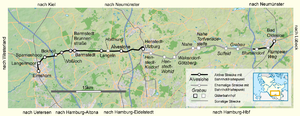Elmshorn-Barmstedt-Oldesloe railway
| Elmshorn–Bad Oldesloe railway | |||||||||||||||||||||||||||||||||||||||||||||||||||||||||||||||||||||||||||||||||||||||||||||||||||||||||||||||||||||||||||||||||||||||||||||||||||||||||||||||||||||||||||||||||||||||||||||||||||||||||||||||||||||||||||||||||||||||||||||||||||||||||||||||||||||
|---|---|---|---|---|---|---|---|---|---|---|---|---|---|---|---|---|---|---|---|---|---|---|---|---|---|---|---|---|---|---|---|---|---|---|---|---|---|---|---|---|---|---|---|---|---|---|---|---|---|---|---|---|---|---|---|---|---|---|---|---|---|---|---|---|---|---|---|---|---|---|---|---|---|---|---|---|---|---|---|---|---|---|---|---|---|---|---|---|---|---|---|---|---|---|---|---|---|---|---|---|---|---|---|---|---|---|---|---|---|---|---|---|---|---|---|---|---|---|---|---|---|---|---|---|---|---|---|---|---|---|---|---|---|---|---|---|---|---|---|---|---|---|---|---|---|---|---|---|---|---|---|---|---|---|---|---|---|---|---|---|---|---|---|---|---|---|---|---|---|---|---|---|---|---|---|---|---|---|---|---|---|---|---|---|---|---|---|---|---|---|---|---|---|---|---|---|---|---|---|---|---|---|---|---|---|---|---|---|---|---|---|---|---|---|---|---|---|---|---|---|---|---|---|---|---|---|---|---|---|---|---|---|---|---|---|---|---|---|---|---|---|---|---|---|---|---|---|---|---|---|---|---|---|---|---|---|---|---|---|---|---|
 |
|||||||||||||||||||||||||||||||||||||||||||||||||||||||||||||||||||||||||||||||||||||||||||||||||||||||||||||||||||||||||||||||||||||||||||||||||||||||||||||||||||||||||||||||||||||||||||||||||||||||||||||||||||||||||||||||||||||||||||||||||||||||||||||||||||||
| Overview | |||||||||||||||||||||||||||||||||||||||||||||||||||||||||||||||||||||||||||||||||||||||||||||||||||||||||||||||||||||||||||||||||||||||||||||||||||||||||||||||||||||||||||||||||||||||||||||||||||||||||||||||||||||||||||||||||||||||||||||||||||||||||||||||||||||
| Locale | Schleswig-Holstein, Germany | ||||||||||||||||||||||||||||||||||||||||||||||||||||||||||||||||||||||||||||||||||||||||||||||||||||||||||||||||||||||||||||||||||||||||||||||||||||||||||||||||||||||||||||||||||||||||||||||||||||||||||||||||||||||||||||||||||||||||||||||||||||||||||||||||||||
| Line number | 9120 | ||||||||||||||||||||||||||||||||||||||||||||||||||||||||||||||||||||||||||||||||||||||||||||||||||||||||||||||||||||||||||||||||||||||||||||||||||||||||||||||||||||||||||||||||||||||||||||||||||||||||||||||||||||||||||||||||||||||||||||||||||||||||||||||||||||
| Technical | |||||||||||||||||||||||||||||||||||||||||||||||||||||||||||||||||||||||||||||||||||||||||||||||||||||||||||||||||||||||||||||||||||||||||||||||||||||||||||||||||||||||||||||||||||||||||||||||||||||||||||||||||||||||||||||||||||||||||||||||||||||||||||||||||||||
| Line length | 52.7 km (32.7 mi) | ||||||||||||||||||||||||||||||||||||||||||||||||||||||||||||||||||||||||||||||||||||||||||||||||||||||||||||||||||||||||||||||||||||||||||||||||||||||||||||||||||||||||||||||||||||||||||||||||||||||||||||||||||||||||||||||||||||||||||||||||||||||||||||||||||||
| Track gauge | 1,435 mm (4 ft 8 1⁄2 in) standard gauge | ||||||||||||||||||||||||||||||||||||||||||||||||||||||||||||||||||||||||||||||||||||||||||||||||||||||||||||||||||||||||||||||||||||||||||||||||||||||||||||||||||||||||||||||||||||||||||||||||||||||||||||||||||||||||||||||||||||||||||||||||||||||||||||||||||||
| Operating speed | 80 km/h (49.7 mph) (maximum) | ||||||||||||||||||||||||||||||||||||||||||||||||||||||||||||||||||||||||||||||||||||||||||||||||||||||||||||||||||||||||||||||||||||||||||||||||||||||||||||||||||||||||||||||||||||||||||||||||||||||||||||||||||||||||||||||||||||||||||||||||||||||||||||||||||||
| Route number | 139 | ||||||||||||||||||||||||||||||||||||||||||||||||||||||||||||||||||||||||||||||||||||||||||||||||||||||||||||||||||||||||||||||||||||||||||||||||||||||||||||||||||||||||||||||||||||||||||||||||||||||||||||||||||||||||||||||||||||||||||||||||||||||||||||||||||||
|
|||||||||||||||||||||||||||||||||||||||||||||||||||||||||||||||||||||||||||||||||||||||||||||||||||||||||||||||||||||||||||||||||||||||||||||||||||||||||||||||||||||||||||||||||||||||||||||||||||||||||||||||||||||||||||||||||||||||||||||||||||||||||||||||||||||
The Elmshorn–Bad Oldesloe railway (also called the Elmshorn–Barmstedt–Oldesloe railway, abbreviated, EBOE or EBO) is a regional railway line that has existed since 1896 in the south of the German state of Schleswig-Holstein. It has been operated since 1981 by the AKN Eisenbahn.
A ten km-long narrow gauge railway was opened from Elmshorn to Barmstedt via Elmshorn by the Elmshorn-Barmstedter Eisenbahn-AG (Elmshorn-Barmstedt Railway Company) on 15 July 1896. On 9 June 1907, this was taken over by the Elmshorn-Barmstedt-Oldesloer Eisenbahn-AG (Elmshorn-Barmstedt-Oldesloer Railway Company, EBOE), which was founded on 3 December 1904 in Elmshorn. On the same day, it opened the Barmstedt–Ulzburg (now Henstedt-Ulzburg)–Oldesloe (now Bad Oldesloe) line as a branch line and licensed the previous narrow-gauge railway as a branch line to allow through traffic to the state railway. The construction of the 42 km-long route cost around 2.9 million marks. Eight steam locomotives were available for operations.
The now 53 km-long standard gauge route passes through a sparsely populated rural landscape. It was built throughout as a single track, but because of its strategic importance as an east-west connection and a northern bypass of Hamburg, its stations were given long passing loops.
Passenger traffic was worthwhile only between Elmshorn and Barmstedt; the section between Barmstedt and Bad Oldesloe was converted to railcar services in 1931. Freight traffic was just adequate. After the division of Germany in 1945 it lacked through freight trains from the east. This improved after the opening of the border crossing at Herrnburg near Lübeck. Business closures and modal shifts ended these traffic flows in the 1970s. No money was avaailble for necessary route reconstruction and the tracks were still laid in a gravel bed.
On 29 September 1973, passenger traffic between Barmstedt and Bad Oldesloe was closed; a rail replacement service already operated between Barmstedt and Alveslohe.
By the end of 1973, the EBOE had abandoned freight traffic from Barmstedt. For some time the AKN still ran freight from Alveslohe via Ulzburg to Henstedt. It was possible to operate freight between Ulzburg and Blumendorf until 31 December 1981. The four km-long remnant from Blumendorf station to Bad Oldesloe was operated as an industrial mainline track from Bad Oldesloe. The track between Ulzburg and Blumendorf has long since been dismantled. The trackless route has been converted to a cycle path. There are information boards close to this cycle path in the Wakendorf II area and it is Europe's longest path through fruit trees.
...
Wikipedia
